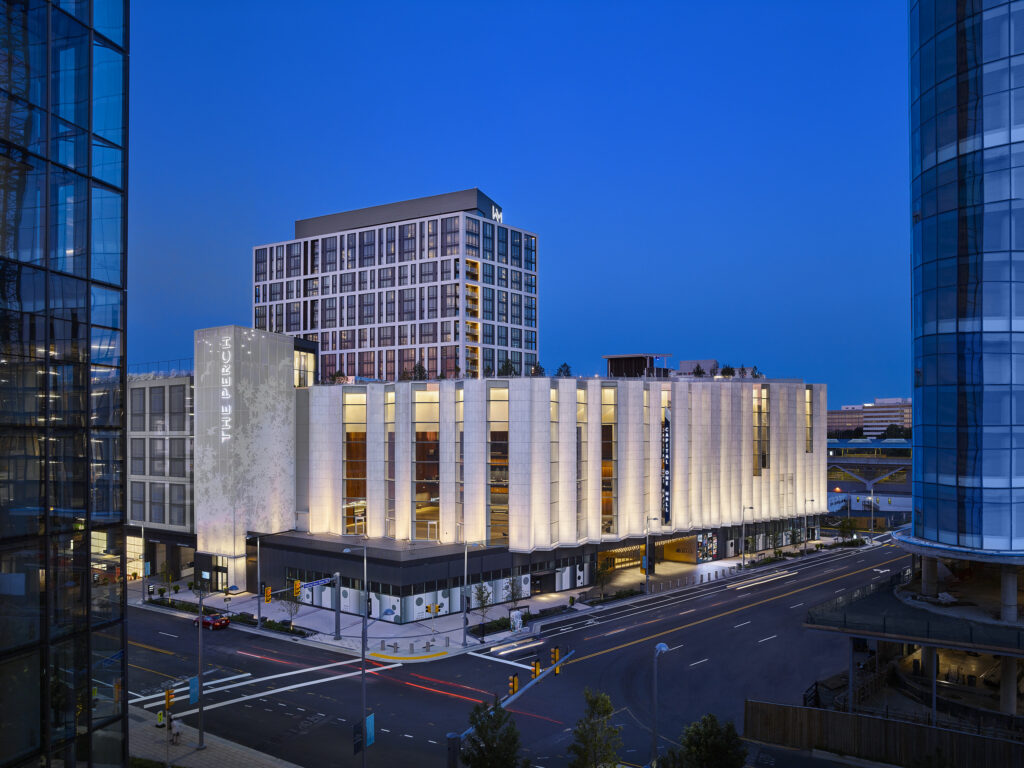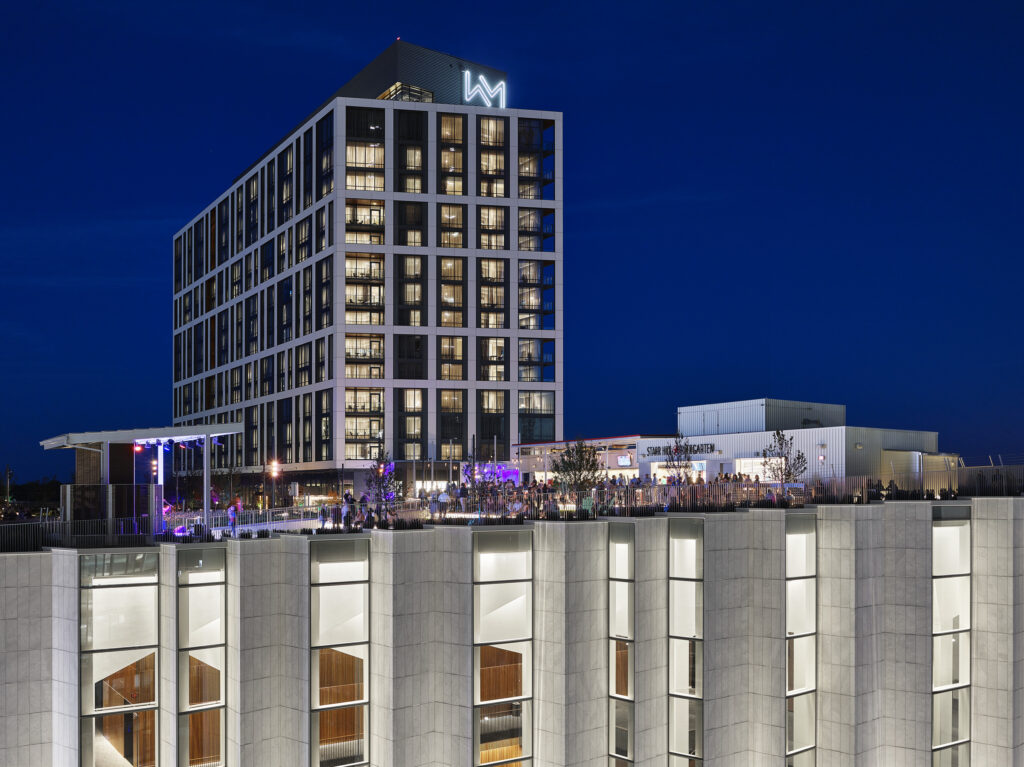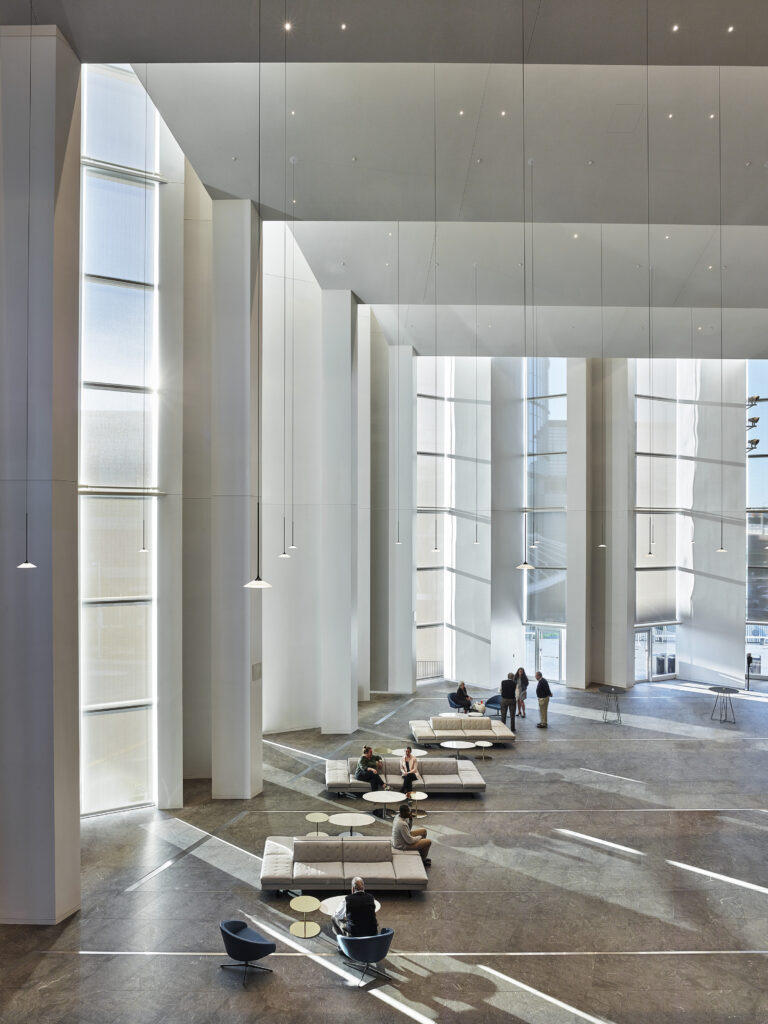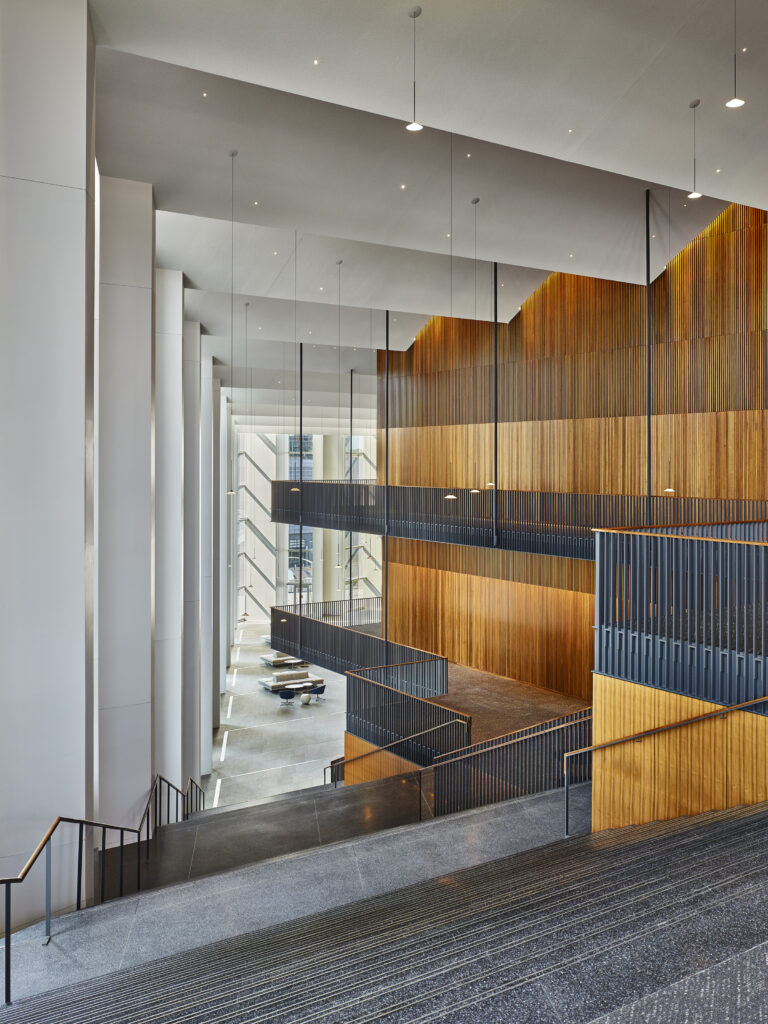By William Richards
HGA’s handsome marble-clad Capital One Hall at Tysons Corner announces a totally different direction for an ex-novo urban area that has been defined less by architectural vision over the years and more by cloverleaf interchanges and white-knuckle merges. The façade’s alternating marble and glass strips was conceived by HGA’s head Tim Carl, FAIA, and design principal Nat Madson, AIA, and was reportedly inspired by Gordon Matta-Clark’s photography—a nod to the interplay of our perception of urban space as its framed, sometimes tightly, by gaps and fissures in the urban fabric.
It’s hard to imagine Gordon Matta-Clark mentioned in the same sentence as anything related to Tysons, but there it is—and HGA’s work to realize Capital One Hall, itself, offers a possible window into a more promising future for the area. One promising future is about scale—and the entertainment and community venue finally completes a corporate campus that has struggled to find a human-scale focal point after the banking behemoth began developing the site a quarter century ago. The other possible future is about community—and Capital One Hall also completes Fairfax County’s plan to make Tysons Corner a cultural destination for more than 25,000 residents who live nearby.





As corporate campuses go, Capital One’s development over almost 24 years has meant a diverse set of design decisions juxtaposed in one place. There’s the gleaming glass tower (the tallest in the metro area), a joint endeavor between HKS Architects, Bonstra Haresign, and CallisonRTKL. A quick walk away is the comparatively low-slung original office block that harkens back to federal office buildings from the 1950s in its massing. (About 50 miles away, the 1960 Altmeyer Social Security Administration Building comes to mind, for which HGA was architect-of-record for its 2021 renovation.) Other small- and mid-size towers dot the site along the periphery of the bank’s triangular property—more bank offices, residences, corporate housing, and a massive, 80,000 square-foot Wegman’s grocery store.
Capital One Hall is the literal center of the pizza pie-shaped property that Capital One has owned (and has been developing) since 2000. Blending spare, almost Nordic gestures, a rich materials palette, and flexible spaces to suit a range of programming, Capital One Hall is really several connected entertainment and community spaces. But it didn’t start that way, says Scott Cryer, AIA, Associate Vice President and Principal at HGA. It started as a brief for more meeting space for intra-bank groups, a community space, and a way to deal with the Wegmans loading dock (which occupies the four sub-floors beneath the concert hall).
“All that together then brought us to our proposal for Capital One Hall, which includes all of the meeting spaces the client needs while also creating a performance space for the community,” says Cryer. “It’s highly flexible for the community’s needs and for Capital One’s needs, and it’s an anchor for the entire campus now”.”
The 1,600-seat main theater, clad in walnut and perforated aluminum panels, has acoustics so perfect it compelled Josh Groban to sing acapella on opening night (a first for him, reportedly). The adjacent black-box theater called “The Vault” holds 225 people the chance to see more intimate productions, one-person readings, or experimental performance pieces.
“From the standpoint of the arts community here, the fact that multiple arts organizations can put on shows here now—it’s been transformative,” says Cryer, who also happens to be an area resident who is involved in several local committees and boards.
Cryer says county residents can apply to have their shows put on in either the Vault or the main theater by going through Arts Fairfax, who vets applications on behalf of Capital One. “These were shows that had to be put on in cafeterias and church basements around the county—and now people can come to the Vault or the main stage,” he says.
Watching a concert or play or operetta is preceded by another kind of performance, which is the physical procession of spaces that all good theaters invest in as a preambulatory experience, from Charles Garnier at his Paris Opera to Edward Durell Stone at his Kennedy Center. You enter the building from the street under an old fashioned marquee, up a grand staircase, into a foyer, and into the atrium, itself on the piano nobile, which can be configured and reconfigured for sitting or standing events (or simple pre-show or intermission chatter). Atop it all on the roof is “The Perch,” a public rooftop co-administered by the county’s park authority, that holds an additional 10,000 people complete with biergarten and park, a number the roof hit on opening night.
For years, area residents have driven to Tysons for Halloween costumes, prom dresses, monogrammed flatware, or the novelty of eating conveyor belt sushi between two escalators. These days, you can take the Metro there. These days, you can also have lots of reasons to never set foot in the mall, too—meeting venues, no fewer than 11 hotels, and dozens of other corporate HQs along NoVa’s tech corridor on the approach to Dulles. There are even some great area parks with real trees. But, with the arrival of a Capital One Hall there is now one more reason to skip the mall and one less reason to complain about a grand urban experiment that might just work out in the end.
Capital One Hall received an Award of Honor for Architecture from AIA Virginia in 2022. Learn more about HGA work, and Capital One Hall’s future performances.
Mueller Associates, Inc.: MEP Engineering
Cushman & Wakefield: Project Development Partner
George Sexton Associates, LLC: Exterior Facade Lighting
Stages Consultants: Theatre Planning, Acoustics and A/V
Thornton Tomasetti: Structural Engineering
Arup: Façade Consultant and Code & Life Safety
William Richards is a writer and editorial consultant based in Washington, D.C. From 2007 to 2011, he was the Editor-in-Chief of Inform Magazine.
